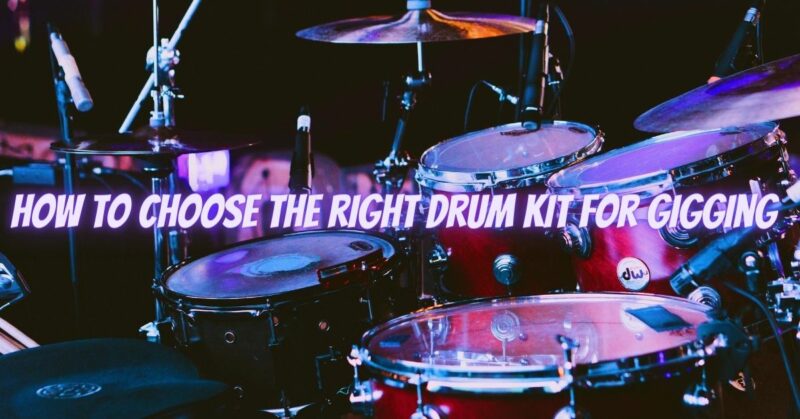Selecting the right drum kit for gigging is a crucial decision for any drummer. A gigging drum set should not only sound great but also meet the specific requirements of live performances, such as portability, durability, and versatility. In this article, we will guide you through the process of choosing the ideal drum kit for gigging, considering factors like sound, construction, hardware, portability, and budget.
- Determine Your Sound Preference: Consider the sound you want to achieve for different musical genres and playing styles. Drum kits come in various configurations, each offering unique tonal characteristics. Experiment with different drum shell materials, such as maple, birch, or mahogany, to find the sound that best suits your playing style and musical preferences. Additionally, consider the sizes of the drums (e.g., 22″ kick drum, 10″, 12″, and 16″ toms) to achieve the desired balance and projection.
- Assess Construction Quality: Look for a drum kit with solid construction and durable materials. Pay attention to the quality of the drum shells, bearing edges, and hardware. High-quality shells produce better resonance and projection, while well-crafted bearing edges ensure optimal drumhead contact. Inspect the hardware, including lugs, tension rods, hoops, and mounts, to ensure they are robust and designed for frequent setup and teardown.
- Consider Portability: For gigging drummers, portability is essential. Look for drum kits that are lightweight, compact, and easy to transport. Consider shell pack configurations (drums only) as they offer more flexibility in terms of portability. Additionally, opt for hardware that is lightweight yet sturdy, and consider features like foldable or telescopic stands to maximize portability.
- Versatility and Customization Options: Choose a drum kit that can adapt to different musical situations. Look for kits that allow you to adjust tuning easily and offer a wide range of sounds. Consider drum kits with multiple tom mounting options, adjustable suspension mounts, and versatile snare drums. This flexibility enables you to customize your drum set based on the specific requirements of each gig.
- Evaluate Hardware Quality: Good hardware is crucial for a reliable and stable drum kit. Check the quality of the drum hardware, including the kick pedal, snare stand, hi-hat stand, cymbal stands, and tom mounts. Ensure that they are sturdy, adjustable, and easy to set up and tear down. Consider features like memory locks for consistent setup, double-braced stands for added stability, and quick-release mechanisms for efficient adjustments.
- Test Playability and Comfort: Playability and comfort are essential for gigging drummers who spend extended periods behind the kit. Sit behind the drum set and assess the ergonomics, adjusting drum heights and angles to ensure a comfortable playing position. Test the responsiveness and feel of the drumheads, pedals, and cymbals to ensure they meet your playing preferences. Consider features like recessed bass drum claws to prevent interference with pedal strokes and ergonomic drum throne designs for enhanced comfort.
- Budget Considerations: Set a budget range and consider drum kits within that range. While high-end drum kits may offer exceptional quality and sound, they might not be practical for every gigging situation. Focus on finding a drum kit that offers the best balance between quality, features, and affordability within your budget.
- Seek Recommendations and Testimonials: Research and gather feedback from experienced drummers, music professionals, and online communities to gain insights into specific drum kit models. Read reviews, watch demo videos, and visit local drum shops to try out different kits before making a final decision. Seek recommendations from fellow gigging drummers who have firsthand experience with various drum sets.
Conclusion: Choosing the right drum kit for gigging is a personal and critical decision that requires careful consideration. Assess the sound, construction quality, portability, versatility, hardware, playability, and comfort of potential drum kits while keeping your budget in mind. Remember, it’s crucial to test and play the drum kit before making a final decision. By taking these factors into account and seeking recommendations from experienced drummers, you can find the perfect drum kit that meets your specific gigging needs and enables you to deliver outstanding performances night after night.


